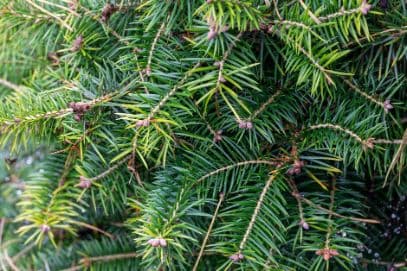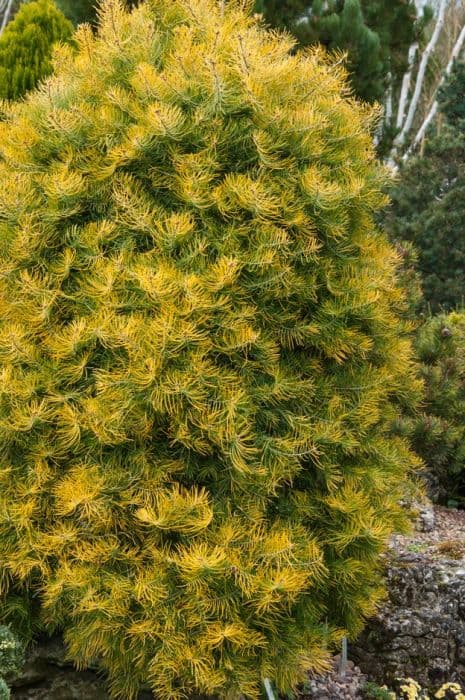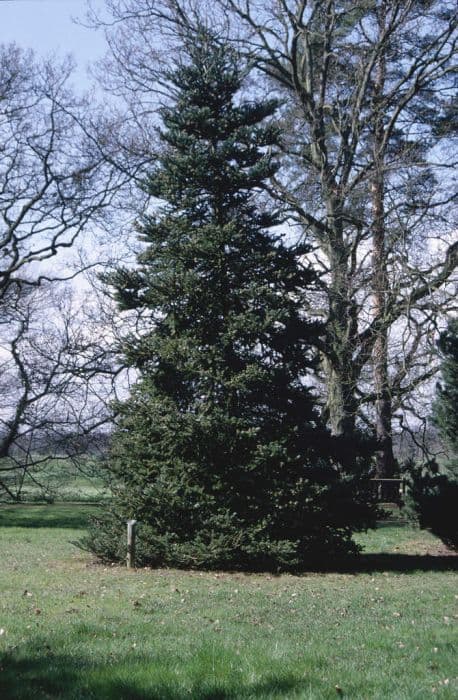Weeping Canadian Hemlock Tsuga canadensis 'Pendula'

ABOUT
The Tsuga canadensis 'Pendula', commonly known as the Weeping Canadian Hemlock, is a unique and visually striking plant characterized by its weeping habit. This conifer features gracefully drooping branches that cascade downwards, creating a sweeping and flowing appearance. The needles of this Hemlock are small, soft, and finely textured with a lush green color that remains consistent throughout the year, adding a touch of evergreen elegance to any landscape. Its branches are layered and spread widely, often sweeping the ground, and the overall shape of the plant can be quite variable, contributing to its unique aesthetic. This artistic, draping form makes the Weeping Canadian Hemlock a standout specimen in gardens. The bark of the Weeping Canadian Hemlock is another point of interest, with its rugged texture and rich color, providing a beautiful contrast to the softness of the foliage. With its distinct presence, this plant is often sought after for its ability to add visual interest and create a focal point in garden design. Hence, the Weeping Canadian Hemlock is appreciated for its ornamental qualities, particularly the weeping branches that lend an air of refinement and tranquility to its surroundings.
About this plant
 Names
NamesFamily
Pinaceae
Synonyms
Weeping Canadian Hemlock, Weeping Hemlock
Common names
Tsuga canadensis 'Pendula'.
 Toxicity
ToxicityTo humans
Eastern Hemlock is not considered highly toxic to humans. While the ingestion of plant parts is generally discouraged due to the presence of certain compounds, such as tannins and volatile oils, accidental ingestion typically does not result in serious poisoning. However, concentrated extracts from the plant have been historically used to cause harm, most notably in the case of the death of the philosopher Socrates. If someone ingests large quantities of Eastern Hemlock foliage, there is a potential for mild stomach upset. It's important to note that individual sensitivities can vary, and any suspected ingestion should be discussed with a medical professional.
To pets
Eastern Hemlock is considered to be of low toxicity to pets. Ingestion of the foliage, in small amounts, is unlikely to result in severe poisoning. However, if a pet consumes a large quantity of this plant, it may experience mild gastrointestinal symptoms such as vomiting or diarrhea. As with humans, individual pets may have different sensitivities, and any consumption of Eastern Hemlock by a pet should warrant monitoring for adverse effects and a consultation with a veterinarian if symptoms appear.
 Characteristics
CharacteristicsLife cycle
Perennials
Foliage type
Evergreen
Color of leaves
Green
Height
10-15 feet (3-4.6 meters)
Spread
3-4 feet (0.9-1.2 meters)
Plant type
Tree
Hardiness zones
3-7
Native area
North America
Benefits
 General Benefits
General Benefits- Landscape Aesthetics: The Weeping Hemlock adds visual interest to gardens with its unique pendulous form and elegant draping branches.
- Shade Provision: Its dense foliage provides ample shade in landscaped areas, making it suitable for creating cool, shaded spots in gardens.
- Habitat for Wildlife: Offers shelter and nesting sites for birds and small mammals.
- Year-Round Interest: Evergreen nature ensures that it provides color and structure to the landscape throughout the year.
- Drought Tolerance: Once established, it can handle periods of drought with less need for frequent watering.
- Erosion Control: The root system can help stabilize slopes and prevent soil erosion.
- Low Maintenance: Requires minimal pruning and is generally pest-resistant, making it easy to care for.
- Tolerates Shade: Grows well in shaded areas where other plants might struggle, increasing gardening options.
 Medical Properties
Medical PropertiesThis plant is not used for medical purposes.
 Air-purifying Qualities
Air-purifying QualitiesThis plant is not specifically known for air purifying qualities.
 Other Uses
Other Uses- Landscape art and bonsai: Due to its weeping form and attractive foliage, Canadian Hemlock can be trained as a bonsai or used in landscape art installations for visual interest.
- Shade for smaller plants: The dense canopy can provide shade for smaller, shade-loving plants in a garden setting.
- Hedge or privacy screen: When planted in a row, Canadian Hemlock can serve as an effective privacy screen or hedge, creating a natural and aesthetic boundary.
- Sound barrier: The thick foliage can help reduce noise pollution when planted alongside roads or between properties.
- Windbreak: It can be used in groupings to serve as a windbreak, protecting more vulnerable landscapes from harsh winds.
- Wildlife habitat: It offers shelter and nesting sites for birds and other small wildlife within its branches.
- Soil stabilization: The root system of Canadian Hemlock can help prevent soil erosion on slopes and banks.
- Seasonal decoration: Branches of Canadian Hemlock can be harvested and used in holiday wreaths and other festive decorations.
- Educational purposes: It can be used in botanical and educational gardens to demonstrate weeping plant forms and conifer growth habits.
- Photography and painting subject: The unique form of weeping Canadian Hemlock makes it a fascinating subject for photographers and artists.
Interesting Facts
 Feng Shui
Feng ShuiThe Eastern Hemlock is not used in Feng Shui practice.
 Zodiac Sign Compitability
Zodiac Sign CompitabilityThe Eastern Hemlock is not used in astrology practice.
 Plant Symbolism
Plant Symbolism- Resilience: Eastern Hemlock, the common name for Tsuga canadensis 'Pendula', is known for its ability to endure harsh conditions, symbolizing the strength to withstand challenges and remain steadfast.
- Longevity: This species of tree can live for a long period, often hundreds of years, symbolizing endurance and the passage of time.
- Protection: With its dense foliage and evergreen nature, the Eastern Hemlock provides shelter for wildlife throughout the year, representing safety and refuge.
- Healing: Historically, parts of the Eastern Hemlock have been used by indigenous peoples for medicinal purposes, representing healing and the power of nature.
 Water
WaterThe Weeping Hemlock (Tsuga canadensis 'Pendula') should be watered deeply and infrequently to ensure its health and vigor. Young trees benefit from watering once or twice a week during dry periods to establish an extensive root system. Established trees generally require less frequent watering; a good soaking every few weeks during dry spells should suffice. Use about 10 gallons per watering session to reach the deep roots, and always check the soil moisture level; it should be moist but not waterlogged.
 Light
LightThe Weeping Hemlock thrives in partial to full shade, making it an ideal plant for shaded landscapes or north-facing gardens. Although it can tolerate dappled sunlight, direct, hot afternoon sun should be avoided to prevent scorching the foliage.
 Temperature
TemperatureThe Weeping Hemlock is hardy and can withstand temperatures ranging from -30 to 90 degrees Fahrenheit, but it thrives best in cooler climates within the range of 60 to 70 degrees. Extreme heat can stress the plant, especially when coupled with direct sunlight.
 Pruning
PruningPruning the Weeping Hemlock is generally done to maintain its shape or remove any dead or diseased branches. The best time to prune is in late winter or early spring before new growth starts. Prune sparingly, as this plant's natural form is usually most attractive; excessive pruning can ruin its weeping habit. Clean cuts should be made at the branch collars to promote proper healing.
 Cleaning
CleaningNot needed
 Soil
SoilThe best soil mix for the Weeping Hemlock is well-draining, moist, and rich in organic matter. It prefers slightly acidic to neutral soil with a pH of 5.5 to 7.0. Incorporating compost or pine bark can help achieve the desired soil consistency and acidity.
 Repotting
RepottingWeeping Hemlocks are slow-growing and typically do not require frequent repotting. Repotting should be done every 3 to 5 years or when the root system outgrows the current container or planting space.
 Humidity & Misting
Humidity & MistingWeeping Hemlocks thrive in moderate to high humidity levels. Aim for around 50% relative humidity or higher. Ensure good air circulation to prevent fungal issues that can arise in very high humidity.
 Suitable locations
Suitable locationsIndoor
Not suitable for indoor growth; needs outdoor environment.
Outdoor
Plant in partial shade, acidic, well-draining soil, and mulch.
Hardiness zone
3-7 USDA
 Life cycle
Life cycleThe life of the Weeping Canadian Hemlock (Tsuga canadensis 'Pendula') begins with seed germination, typically occurring in a moist, shaded environment since the seeds require such conditions to sprout successfully. After germination, the seedling stage follows, during which the young hemlock establishes roots and begins to grow its characteristic weeping branches, albeit at a slow rate. As it enters the juvenile stage, the weeping hemlock gradually matures and increases in size, developing a distinctive pendulous form with dense foliage. It then reaches the adult stage, where it becomes capable of reproduction, formulating cones—small male cones shedding pollen and larger female cones developing into seed-bearing structures after fertilization. Over many years, it maintains its reproductive capacity while continuing to grow, albeit slowly, reaching heights of up to 10-15 feet and widths of up to 25 feet in cultivation. Finally, as it enters the senescence stage, growth slows considerably, and the plant may become more susceptible to diseases and environmental stresses before eventually dying.
 Propogation
PropogationPropogation time
Late summer to early fall
The most popular method of propagating the Canadian Hemlock 'Pendula' is by softwood cuttings. This is typically done in late spring to early summer when new growth is mature enough yet still in the softwood stage. Cuttings should be about 6 to 8 inches long, and the lower needles removed to expose the nodes where roots will form. It's important to dip the base of the cuttings in a rooting hormone to encourage root growth. Then, the cuttings are inserted into a well-draining propagation medium such as a mix of half peat and half perlite, ensuring the exposed nodes are buried. The environment should be kept humid, and the medium should be consistently moist but not waterlogged. Roots usually develop within a few weeks to a few months, after which the new plants can gradually acclimate to less humid conditions before transplanting.









